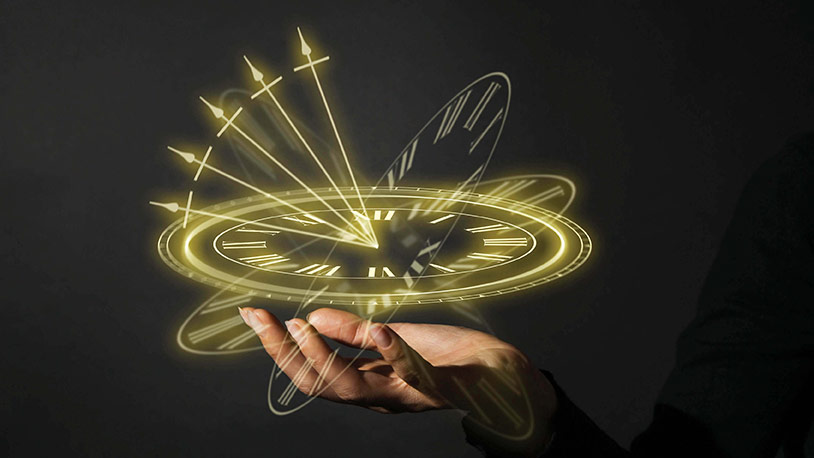
LISI Speaker Series
The Liebman Institute for Science Innovation’s speakers series brings cutting-edge science to the forefront of our community and collective consciousness. It maps the intersection between scientific discovery and innovative application where ‘aha’ moments are always transformative, science fiction is simply prediction, and everything becomes possible.
Presentations draw on various disciplines and are chosen to keep pace with the extreme—often breathtaking—rate of scientific developments. Interacting with leading researchers and visionaries in a venue for sharing ideas and fostering imagination is guaranteed to be inspirational. These events will keep you relevant in a rapidly changing landscape and heighten your awareness and anticipation of potential science-based opportunities, impacts, and solutions.
Presentations feature a meet-and-greet with guest speakers and refreshments.
Transparency, Opacity, and Iridescence in Glass
Friday, April 25, 2025 | 5:15–7:30 p.m.
Fee: $7 per person
Katherine Gray, a world-renowned glass artist, brings her expertise to the LISI Speaker Series in an illuminating presentation on the creative technologies behind art glass. Gray will explore this compelling medium and how the interplay of light, structure, and perception transforms ordinary glass into an extraordinary artistic statement. And did you know that metal oxides developed by NASA for spacecraft windows create dazzling iridescent effects? From historical glass artifacts to cutting-edge innovations, Gray’s talk will reveal the hidden science behind this ancient yet futuristic material.
“I use a material that we don’t generally ‘see’: glass. It is often flawlessly clear and colourless, hence invisible in that regard, but also it can be so ubiquitous and banal that it does not register in our psyches either. It is a material that allows us unparalleled connectivity (via smart phones and fibre optics) yet also serves to separate us. To my mind, these two polarities are what set this material apart from so many others, and one of the reasons that I feel compelled to keep working with it as an artistic medium. It is both present and absent, known and unknown, and vacillating between a state of mundane familiarity and otherworldly perfection." -Katherine Gray
Join us for an evening of insight, innovation, and artistry as Katherine Gray uncovers the mesmerizing science behind blown glass and its limitless creative potential.
About Katherine Gray:
Katherine Gray is an acclaimed glass artist whose work bridges the realms of science and art. She received her undergraduate degree from the Ontario College of Art in Toronto and her Master of Fine Arts from the Rhode Island School of Design. Her work has been exhibited in prestigious institutions, including the Corning Museum of Glass, the Toledo Museum of Art, and the Museum of Glass in Tacoma, Washington. Gray is a recipient of the Libenský/Brychtová Award from the Pilchuck Glass School and has been inducted into the College of Fellows of the American Craft Council. In addition to her artistic career, she is a Professor of Art at California State University, San Bernardino, and a frequent juror and curator in the glass art world.
Register for Transparency, Opacity and Iridescence in Glass »
Spring 2025
Transparency, Opacity, and Iridescence in Glass
Friday, April 25, 2025 | 5:15–7:30 p.m.
Fee: $7 per person
Katherine Gray, a world-renowned glass artist, brings her expertise to the LISI Speaker Series in an illuminating presentation on the creative technologies behind art glass. Gray will explore this compelling medium and how the interplay of light, structure, and perception transforms ordinary glass into an extraordinary artistic statement. And did you know that metal oxides developed by NASA for spacecraft windows create dazzling iridescent effects? From historical glass artifacts to cutting-edge innovations, Gray’s talk will reveal the hidden science behind this ancient yet futuristic material.
“I use a material that we don’t generally ‘see’: glass. It is often flawlessly clear and colourless, hence invisible in that regard, but also it can be so ubiquitous and banal that it does not register in our psyches either. It is a material that allows us unparalleled connectivity (via smart phones and fibre optics) yet also serves to separate us. To my mind, these two polarities are what set this material apart from so many others, and one of the reasons that I feel compelled to keep working with it as an artistic medium. It is both present and absent, known and unknown, and vacillating between a state of mundane familiarity and otherworldly perfection." -Katherine Gray
Join us for an evening of insight, innovation, and artistry as Katherine Gray uncovers the mesmerizing science behind blown glass and its limitless creative potential.
About Katherine Gray:
Katherine Gray is an acclaimed glass artist whose work bridges the realms of science and art. She received her undergraduate degree from the Ontario College of Art in Toronto and her Master of Fine Arts from the Rhode Island School of Design. Her work has been exhibited in prestigious institutions, including the Corning Museum of Glass, the Toledo Museum of Art, and the Museum of Glass in Tacoma, Washington. Gray is a recipient of the Libenský/Brychtová Award from the Pilchuck Glass School and has been inducted into the College of Fellows of the American Craft Council. In addition to her artistic career, she is a Professor of Art at California State University, San Bernardino, and a frequent juror and curator in the glass art world.
Fall 2024
Hall of Human Origins
Friday, November 8, 2024 | 5–8:30 p.m.
Join us for an unforgettable night as the Liebman Institute for Science Innovation (LISI) unveils its much-anticipated Hall of Human Origins. This unique event blends science, art, and technology to reflect on our place in the universe and what it means to be human.
Keynote: Art Fuels Science Fuels Art
John Gurche
The blend of art and science is intoxicating. Visions that can arise in making art are fueled by the potent revealer of worlds that is science. In the keynote address, paleoartist John Gurche will discuss how art and science are interwoven in his work bringing human ancestors back to life.
- About John Gurche
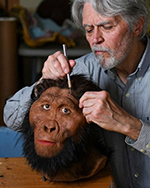
John Gurche’s work has been featured in thirteen issues of National Geographic Magazine, with four covers. He has fifteen sculptures in the Smithsonian’s Hall of Human Origins, and his reconstructions can be seen in museums worldwide, from South Africa to the Republic of Georgia. He has made trips to Africa nine times to study the fossil remains of our ancestors and has been out in the field in northern Kenya with the Leakey family as they searched for ancient humans there. For nine years, he co-taught a course in human origins at Cornell University. In the early 1990s, he co-led a tour of prehistoric art caves in France and Spain. He has been a guest on Science Friday and has been interviewed by National Geographic and others for videos available online. He has lectured at universities and museums around the world. He has authored two books: Shaping Humanity: How Science, Art and Imagination Help us Understand our Origins and Lost Anatomies: The Evolution of the Human Form.
Homo naledi: A Journey into the Dark
Dr. John Hawks
Ten years ago, our team discovered an unexpected species in South Africa. Deep in the Rising Star cave system, the fossil bones posed many mysteries. How was this unknown relative related to us? How did it survive alongside our own evolving species more than 200,000 years ago? Most mysterious: Why were so many of its bodies deep within this cave? I will share the latest scientific discoveries about Homo naledi, which are helping us to understand more about this species and the lives of the individuals we have uncovered. The work is raising new questions about how our species evolved.
- About Dr. John Hawks
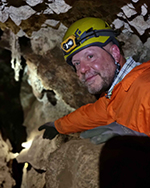
John Hawks is an internationally recognized expert on human evolution and genetics. He has been at the University of Wisconsin-Madison since 2002. He is presently the Vilas-Borghesi Distinguished Achievement Professor of Anthropology and a visiting professor at the University of the Witwatersrand. In addition to his work on Homo naledi at Rising Star, and other fossil sites in South Africa, he is known for his work on the genetics of humans our ancient relatives. His work has shown the rapid evolution of modern humans in the last phase of our evolution and has emphasized the genetic connections between Neanderthals and recent people. He has done fieldwork in Africa, Asia, and Europe, combining skeletal evidence from fossils with new information from genetics to uncover how humans evolved.
Hawks’ work has been featured in documentaries from PBS Nova, PBS Secrets of the Dead, National Geographic Channel, Science Channel, and the BBC. Print coverage of his work has included cover and feature articles in Discover, Scientific American, Archaeology, Science News, New Scientist, coverage in the New York Times, USA Today, Time, Der Spiegel, and many others. He lives outside of Madison, Wisconsin, with his wife, Gretchen, and their four children.
Spring 2024
Time: Behind and Beyond the Clock
Friday, April 26, 2024 | 6–8:30 p.m.
John Clark (CEO – Masterclock, Inc.) and Dr. Demetrios Matsakis, Astrophysicist (Chief Scientist – Masterclock, Inc.)
We set the alarm, we run to catch a plane, we celebrate birthdays, and we watch a fleeting sunset knowing the sunrise always comes too soon. We are creatures of our clocks, tick tick-ticking away. There’s never enough time in a day unless, of course, we’re waiting in line. Are we consumed with time, or is the time consumed by us? How do we define time?
Demetrios Matsakis, astrophysicist and retired Chief Scientist at the US Naval Observatory’s atomic clocks, will tell you straight out “You can’t define time”…but, he doesn’t hesitate to define a second - “it’s 9,192,671,770 periods of oscillation of an undisturbed cesium atom” by the way! Matsakis, now chief scientist at MasterClock, Inc., will take us on a journey through the fascinating history of time, the science behind its measure, and the technology of time transfer. Next, John Clark, CEO of Masterclock, Inc., will explore the intricate applications of time in diverse realms such as aerospace and defense, commercial enterprise, automation, and media. His company, Masterclock, Inc., is a small multimillion-dollar international company that builds timing systems synchronized to the Naval Observatory’s satellites. With Matsakis’ science and Clark’s entrepreneurship, they team up to provide precision timing for the world’s most time-sensitive users where a nanosecond difference can have catastrophic and/or astronomically expensive consequences.
Watch the tales of two real-life time lords….it’s about time! See highlights below or watch the entire video.
- About John Clark
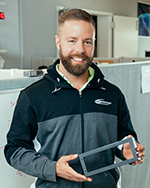
John Clark graduated from the University of Missouri’s Trulaske College of Business with both a B.S. and a B.A. in Marketing. Beginning as a sales manager at Masterclock, Inc., he soon moved up to general manager and then to CEO, a position in which, for the last nine years, he has led the company into the international arena with just 25 employees. He has integrated precision timing solutions for industry leaders including NASA, Lockheed Martin, the Department of Defense, Federal Aviation Administration, ABC, NBC, CBS, IBM, Samsung… the list goes on. Whether it’s helping our astronauts ensure timely liftoffs or helping broadcast studios ensure smooth programming transitions, Clark’s entrepreneurial spirit has helped keep the world in synch by supporting mission-critical applications around the globe and beyond. Clark has been honored with the President’s “E” Award for Exports from the U.S. Department of Commerce; the Exporter of the Year Award issued from the State of Missouri; a Certificate of Special Congressional Recognition from the United States House of Representatives, and the Employer of the Year Award from the City of St. Charles, MO.
- About Dr. Demetrios Matsakis
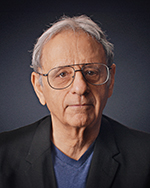
Dr. Demetrios Matsakis attended MIT as an undergraduate and received his Ph.D. in physics from UC Berkeley, where he studied under Nobel Laureate Charles Townes, the inventor of the maser and laser, and built specialized masers in order to observe interstellar dust clouds where stars are born. Subsequently, he joined the U.S. Naval Observatory building water vapor radiometers and doing interferometry to observe quasars and galaxies at the edge of the observable universe. Measuring variations in the earth’s rotation and orientation piqued his interest in time and its measure. Dr. Matsakis then spent the next 25 years working hands-on with most aspects of timekeeping - from clock construction to running the USNO's Time Service Department, to international policy. He has published over 150 papers and counting. He is the author of the recently published An Introduction to Modern Timekeeping and Time Transfer, Springer 2023. He is an award-winning scientist whose oversight of our nation’s ultra-precise clocks has been responsible for the smooth functioning of everything from the internet to our global positioning systems.
If you need an accommodation or a sign language interpreter, contact the Access and Disability Services department at (815) 455-8766 or disabilityservices@mchenry.edu.
